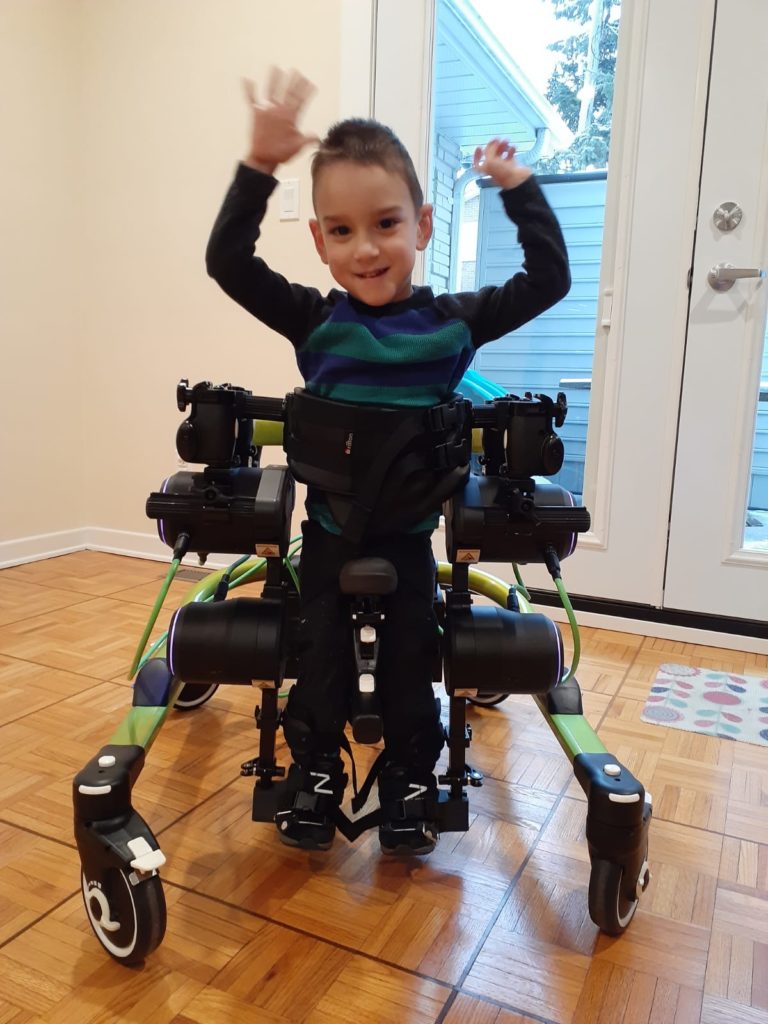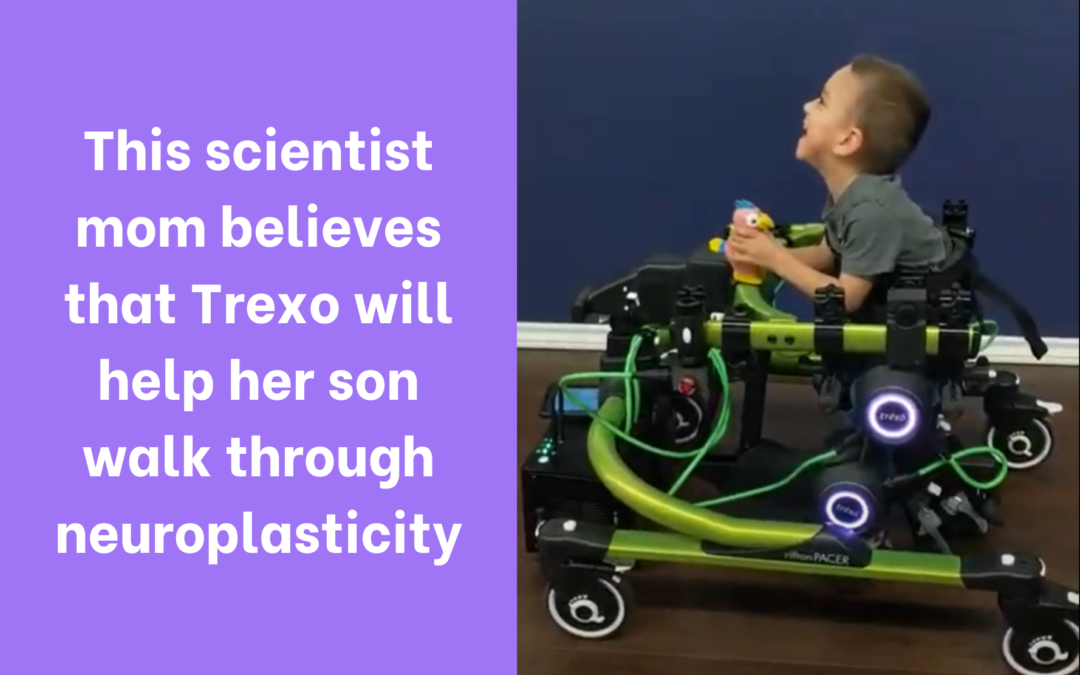Families pursue the Trexo for many different reasons. For Clarisse Mark, who is a brain scientist and mother of 3-year old twins Lucas and Mellie, the answer lies in neuroplasticity.
Meet Lucas
When Lucas and his family arrived at the Trexo Robotics office, immediately everyone got excited to watch him try the Trexo Home for the first time. That’s because Lucas, who is 3-years old, has an incredibly contagious smile and positive attitude. Although a little nervous at first, Lucas quickly warmed up to the idea.
Lucas has cerebral palsy. His twin sister Mellie and him were born premature at 25 weeks. They spent the first 4 months of their lives in the neonatal intensive care unit (NICU). Thankfully both babies survived, but Lucas suffered a brain injury due to lack of oxygen. Eventually, the doctors started losing hope and called his parents to disconnect him. Lucas, however, had other plans and showed his superpowers and pulled through! Now, Lucas’s parents are determined to do everything they can to help him walk.
Clarisse’s approach to helping Lucas get stronger
Like many parents, Clarisse and her husband, Juan, had to learn to navigate the incredibly complex management of cerebral palsy and what it meant for their child. Unlike most parents, they used Clarisse’s extensive knowledge of the brain to guide their decisions in how to help Lucas be the best that he can be. You see, Clarisse has a PhD in biomedical engineering related to brain function and prior to Lucas’s diagnosis worked in research studying concussions.
From Clarisse’s previous experience, she knew that the brain creates new pathways with repetition. This mechanism is called neuroplasticity. To get the repetition, Lucas was using walkers (or gait trainers) and the UpSee, as well as ladders. Additionally, Lucas had his weekly occupational therapy. But even with daily effort, getting the amount of necessary repetition was still a challenge and they knew it wasn’t enough.
As Lucas grew, his body changed and the heavier he got, the more difficult it became for him to practice learning how to walk. Clarrise also knew that with continuous repetition of incorrect walking, his brain would acquire weird ways of walking that wasn’t always the most effective. Neuroplasticity isn’t selective of good behaviors only!
How can the Trexo help?
In Lucas’s case, he doesn’t like movement and noise that aren’t given by a human. Would that impact his interest in the Trexo?
Lucas quickly understood what it’s like to walk correctly once he started with the Trexo. With Mellie by his side and hands free to toss a ball, Lucas took 100, then 200, then 300 steps without even breaking a sweat! He didn’t seem to mind being in the Trexo at all.
Something else happened during that session. Lucas who has always depended on his mom to help him walk, realized that she wasn’t there helping him. His knees were bending and he was striking the ground with his heels, but his mommy was far away. With this new exciting realization, Lucas started working even harder and sent the initiation on his Trexo way up. Suddenly, a whole hour has gone by and Lucas has taken 1,699 steps!

Repetition and neuroplasticity
Lucas is a very bright and hard-working boy. As long as he can get the help, he can do the work. The Trexo, his parents think, will fit in nicely with everything he is already doing at home to stay active. But Clarisse knows “we’re fighting against time to get him walking before he gets heavier and picks up bad habits”.
When Clarisse was working as a scientist, she learned that “irrespective of what you have, if you work, you can create new pathways”. In fact, research has shown neuroplasticity in action in men with stroke who re-learn how to walk in rehab. Clarisse wondered why the same wasn’t true for children with cerebral palsy.
Before age 7, a child’s brain is like a sponge. “You must give the child hope that they can overcome their limitations”. And every time there’s a growth spurt, the child and the parents must work even harder because the body will change. To that idea Clarisse says “It’s doable, don’t give up on it!”.
With diligence and hard work, they have already seen great progress. They visited SMILE Therapy for several intensives to work on their goals and continue doing these exercises at home. Since then, Lucas has started singing and picking up cups with both hands.
Lucas & his Trexo
However, there’s still a lot of work to be done. They have started using their Trexo Home in December 2019 are waiting to find out how it helps Lucas. Within the one and a half months they have used the Trexo, they have already seen changes in and out of the Trexo.
He is now able to walk with a much faster speed, going 60 steps/minute from the initial 30 steps/minute that he was comfortable with. He has also increased his weight bearing and now can walk without any weight support. Notably his initiation has also gone up suggesting he is really putting in the effort to walk in the Trexo.
The skills Lucas learned in the Trexo are also transferable to his regular walker which he practices daily. According to Clarisse, ” his endurance increased incredibly since starting the Trexo” Lucas can also stand much straighter and for longer periods of time. Most recently, his parents noticed he can lift his hips from his chair simply by pushing off his feet, all by himself!
Lucas needs your help! His parents want him to access as much therapy as possible and are running a fundraiser to help with the costs. If you would like to help, you can make a donation here.
Looking to find out why other parents love the Trexo? Check out how the Trexo has given freedom to Luz and her family, and then head on and watch before and after Iris used the Trexo for 5 months.
Curious what physical therapists think? Read Joanne Weltman of SMILE Therapy share her thoughts on the Trexo.
Have questions about the Trexo? We can help, just leave your information below!


Recent Comments